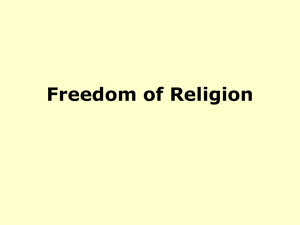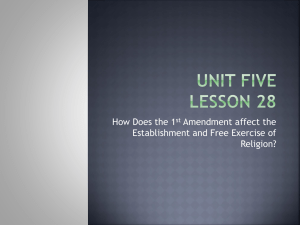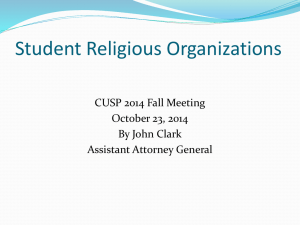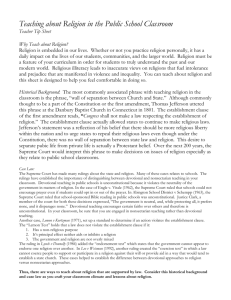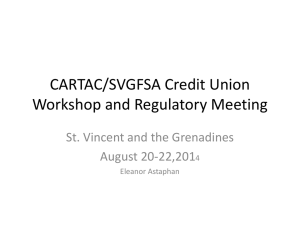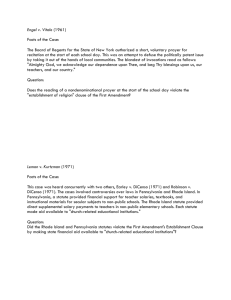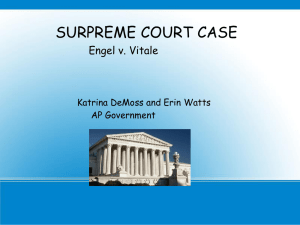The Establishment of Religion
advertisement
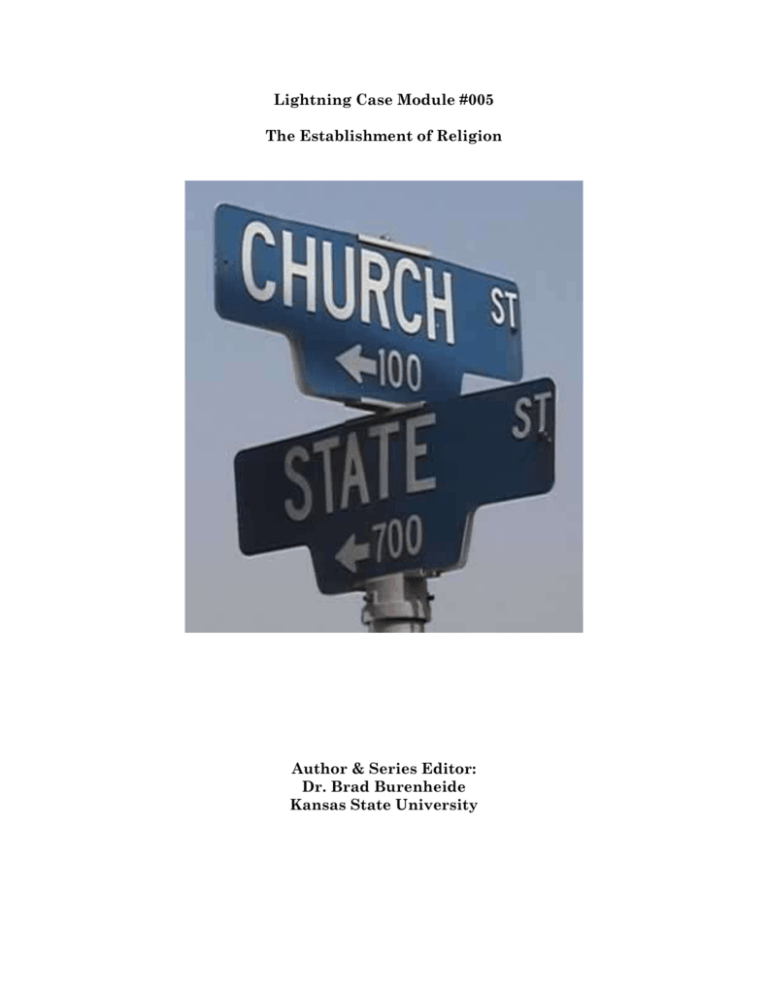
Lightning Case Module #005 The Establishment of Religion Author & Series Editor: Dr. Brad Burenheide Kansas State University Contents For Teachers: Overview of Lightning Case Module 3 Introduction to the Controversy 7 The Cases 8 West Virginia State Board of Education v. Barnette (1943) Tinker v. Des Moines Independent School District (1969) Lemon v. Kurtzman (1970) Lee v. Weisman (1992) Santa Fe Independent School District v. Jane Doe (2000) Safford Unified School District v. Redding (2008) For Teachers: More About the Cases (decisions and more) 11 Final Assessment: Reading a Professional Journal Article 13 Bibliography 14 2 For Teachers: Overview of Lightning Case Model Under the ruling levied in Marbury v. Madison, the Supreme Court became the institution in the American legal system that serves as the ultimate arbiter of issues of constitutional law. In the opinion, Justice John Marshal noted that “the judicial power of the United states is extended to all cases arising under the Constitution…It is also not entirely unworthy of observation that, in declaring what shall be the supreme law of the land, the Constitution, itself is first mentioned, and not the laws of the United States generally, but those only which shall be made in pursuance of the Constitution, have the rank (Marbury v. Madison, 1803).” Under this system of judicial review, it becomes extremely important for students to understand the rights contained with the Constitution and the subsequent Bill of Rights as the Constitution is the ultimate law of the United States. As precedents developed, the scope of the rights of citizens has evolved over time. Thus, it becomes important for citizens to follow this evolution and how the courts currently measure these rights. As Vontz and Leming noted, the use of Supreme Court cases lend themselves well to certain methods (Vontz & Leming, 2003). But, in this specific case, it is important to realize that the method must be integrated with the content. Vontz and Lemming further suggest civics educators who utilize active and participatory strategies, analyze documents and issues, teach with relevant topics, and teach civics content relevant to democratic citizenship can best motivate students to 3 acquire knowledge of citizenship. One of the means of doing this is through the analysis of Supreme Court cases. The case study method of court decisions can engage students in gaining key knowledge through the analysis of important cases (McDonnell, 2002; Long, 1994). Vontz and Leming denote however that the understanding of the “bigger topics” of citizenship can be collected from the study of Supreme Court cases than the law students analyzing cases for method and specific topics of study (Vontz & Leming, 2003). These cases can allow students to investigate facts, issues, arguments, context, civic principles, and higher order thinking skills (Knapp, 1993; Leming, 1991). While there are common strategies to dissect cases of the Supreme Court, many of them can be heavily involved and use up a large amount of time in the classroom. Hanna and Dettmer (2004) encourage the teacher when designing assessments to maintain a balance between reliability, authenticity, and economy. Reliability would be accuracy of the measurement. Authenticity deals with the realworld application of knowledge to encourage transfer of learning. Economy deals with the use of time, effort, and energy in administering the assessment. Where economy focuses on the great “enemy” of the teacher—time—the teacher must consider if the strategy is the optimal and most appropriate use of time. In their article encouraging the use of Supreme Court cases, Vontz and Leming (2003) called for the use of Socratic seminars and moot court cases to effectively analyze the thinking of the court, the institution of the case in an historical context, and by 4 taking an active role in the participating of the activity, becoming content experts of the case. But is this the best use of time in the classroom? Does the depth of content in this instance supersede the coverage of breadth? This study intends to analyze this question by employing a strategy that employs a significant quantity of cases without sacrificing the apparent quality of learning. Description of the Model The “Lightning Case” method discussed in this study is rooted in a sound literature base of experiential learning. Kolb (1984) and Kolb and Lewis (1986) provide a model for experiential learning or having students actively engaged in testing explanatory ideas created by the student. Mukhamedyarova (2005) explored the idea of interactive learning and evaluated five strategies commonly used. O’Brien (2003) discussed a model for students to engage in historical prediction making. Finally, Hess (2002) and Parker (2003) illuminated the nature of controversial deliberation in the classroom and provided guidelines for teachers to follow. Through the sources cited above, a model was constructed that causes students to be actively engaged in the analysis of cases, make predictions based upon their knowledge of the Constitution, and discuss with fellow students, albeit briefly, about their decisions and rationale. Figure 1 provides a visual overview of the model. 5 Figure 1: An Overview of the “Lightning Case” Model Teacher Guides Overview of Right/Concept in Question Students deliberate a number of illustrative cases dealing with the concept. Students tackle a Students conceptualize number of the boundscases of the illustrative right/concept in the eyes dealing with the of the law. concept. The model provides students with the opportunity to utilize several cases to develop their own conceptualization of the boundaries of liberty within society and in the “eyes of the law.” The teacher provides a brief overview of the rights enumerated in the Constitution based upon the specific concept that will be addressed. After this introduction, several cases are presented to the student in a written or oral format with a short synopsis of the key facts of illustrative Supreme Court cases. Pending on the teacher’s preference, students may be given the opportunity to deliberate with their classmates, or they will create their own decision of the case. After the court’s actual decisions are shared with the students with brief rationale for their decision, students conceptualize the boundary of the right or concept discussed in the “Lightning Case” session. 6 Introduction to the Controversy Congress shall make no law respecting an establishment of religion, or prohibiting the free exercise thereof; or abridging the freedom of speech, or of the press; or the right of the people peaceably to assemble, and to petition the Government for a redress of grievances. --The First Amendment For about 40 years after the ratification of the Constitution, it was actually conceived that the Establishment Clause found in the First Amendment of the United States Constitution was applicable only at the Federal level. It officially became incorporated at the state level in the 1940’s. The case that incorporated clause was Everson v. Board of Education. In this case, Justice Hugo Black wrote: The "establishment of religion" clause of the First Amendment means at least this: neither a state nor the Federal Government can set up a church. Neither can pass laws which aid one religion, aid all religions, or prefer one religion over another. Neither can force nor influence a person to go to or to remain away from church against his will or force him to profess a belief or disbelief in any religion. No person can be punished for entertaining or professing religious beliefs or disbeliefs, for church attendance or non-attendance. No tax in any amount, large or small, can be levied to support any religious activities or institutions, whatever they may be called, or whatever form they may adopt to teach or practice religion. Neither a state nor the Federal Government can, openly or secretly, participate in the affairs of any religious organizations or groups, and vice versa. In the words of Jefferson, the clause against establishment of religion by law was intended to erect "a wall of separation between church and State.” As with other Modules, we will look at the cases in chronological order to help identify and delineate the “wall of separation.” 7 The Cases Abington School District v. Schempp (1962) In Pennsylvania Public Schools in the early 1962, students were required at the start of each school day to read at least ten verses from the Bible. Afterwards, school authorities required the recitation of the Lord’s Prayer. Students could be excused from this requirement by a written note from their parents. In a similar case at the time, Murray v. Curlett, professed atheists challenged prayer requirements. Question: Does the Pennsylvania law and Abington’s policy violate the Establishment clause of the First Amendment? Marsh v. Chambers (1982) Ernest Chambers, a member of the Nebraska legislature, challenged the practice of the legislature having a prayer recited by a chaplain chosen by the state and paid out of public funds. The district court supported Chambers on the use of public funds. The court of appeals supported Chambers on prayer practice. Both parties appealed to the U.S. Supreme Court. Question: Does the practice of having a chaplain recite a prayer at the start of each legislative session violate the Establishment Clause of the First Amendment? Rosenberger v. University of Virginia (1994) Ronald W. Rosenberger was a student at the University of Virginia. He asked the University for $5,800 from the student activities fund to subsidize the publishing of Wide Awake: A Christian Perspective at the University of Virginia. The University refused funding because it primarily promoted or manifested “a particular belief in or about a deity or an ultimate reality” which was prohibited by University guidelines. Question: Did UVa violate the first amendment rights of the Christian magazine staff by denying them the same funding it made available to secular student-run mags? 8 Santa Fe Independent School District v. Doe (1999) Prior to 1995, a student elected as the Santa Fe High School student council chaplain delivered a prayer. The prayer was described as overtly Christian and was announced over the p.a. system before each home varsity football game. Two families filed suit. As the suit was pending, the district changed its policy to allow student-initiated and student-led prayers at home games. Two student elections would be held to determine whether the invocations should be delivered and who should lead them. The students authorized the prayers and selected a spokesperson. Question: Does the Santa Fe ISD policy permitting student-led & student-initiated prayer violate the Establishment Clause of the First Amendment? McCreary County v. ACLU (2004) The American Civil Liberties Union sued three county governments in Kentucky for displaying framed copies of the Ten Commandments in their courthouses and public schools. The ACLU’s main argument was that the displays violated the establishment clause by advocating for the advancement of religion. The displays were: 1) displayed in isolation; 2) displayed with other religious passages; and 3) presented in a displayed in a presentation entitled “Foundations of American Law,” Question: Does the display of the Ten Commandments advance religion sufficiently to violate the Establishment Clause? Van Orden v. Perry (2004) Thomas Van Orden sued the State of Texas arguing that a Ten Commandments monument on the grounds along with other monuments of the state capitol building represented an unconstitutional government endorsement of religion. Orden argued this violated the Establishment Clause. The District Court and the Fifth Circuit Court of Appeals ruled against Orden and said the monument served a valid secular purpose and would not appear to a reasonable observer to represent a government endorsement of religion. Question: Does a Ten Commandments monument on the grounds of a state capitol building violate the establishment clause? 9 For Teachers: More About the Cases Abington School District v. Schempp (1962) The Court voted 8-1 that the government law violated the Establishment Clause of the First Amendment as they were essentially religious ceremonies “intended by the State to be so.” Justice Clark stated that “the ability of a parent to excuse a child from these ceremonies by a written note was irrelevant” because the school still continued to violate the Establishment Clause. Marsh v. Chambers (1982) In a 6-3 vote, the Court upheld the chaplaincy practice. Citing historical custom, Chief Justice Warren Burger stated that prayers by state-supported legislative chaplains can be traced back to the First Continental Congress and they were the framers of the Bill of Rights. This practice, continued Burger, was “part of the fabric of our society.” An invocation for Divine guidance was not an establishment of religion, but, a “tolerable acknowledgment of beliefs widely held among the people of this country.” Rosenberger v. University of Virginia (1994) The vote was 5-4 and the court held that the University’s denial of funding imposed a financial burden on his speech and was discriminatory. If the University promoted funding for speech, it must promote all forms of it equally. Because they promoted past publications regardless of religious content, the Court stated that the University’s could not stop religious speech, and then fund atheist speech. The exclusion of several views would be just as offensive as the exclusion of only one. Santa Fe Independent School District v. Doe (1999) The Court voted 6-3 stating that the District’s policy violated that the prayer violated the Establishment clause. It involved perceived and actual government endorsement of the delivery of prayer at school events. In the dissent, Rehnquist, Scalia, and Thomas noted that the Court’s opinion bristled “with hostility to all things religious in public life.” 10 McCreary County v. ACLU (2004) In a 5-4 decision, the Court ruled the displays violated the Establishment Clause as their purpose had been to advance religion. The Court ruled that an observer would conclude the displays were for endorsing religion. The third example was a means by which the county reached “for any way to keep a religious document on the walls of the courthouses.” Van Orden v. Perry (2004) In a 5-4 decision the Court held that the Establishment Clause did not bar the monument on the grounds of the Texas state capitol. The majority of the court deemed that the Texas monument was consistent with the nation’s tradition of recognizing the Ten Commandments’ historical meaning. Additionally, the opinion stated that “simply having religious content or promoting a message consistent with religious doctrine does not run afoul of the establishment clause. 11 Final Assessment: For the 2013-2014 term of the Supreme Court, the Court will tackle the case listed below. You are to view the facts of the case below and render your decision. Provide legal reasons for what you are to do below. Town of Greece, New York, v. Galloway At issue: Public prayer in town meetings. The case: The Town Board of this Rochester suburb had long opened its monthly public sessions with individual prayers. The policy was challenged because virtually all of those invited to offer prayers were Christians, so the board for a time asked a few others-- including a Wiccan, Baha'i leader, and Jewish lay person-- to offer invocations. But local citizens Susan Galloway and Linda Stephens nevertheless sued. The arguments: A federal appeals court found the practice an unconstitutional mix of church and state, and that local officials were not diligent enough seeking more diverse voices from other faiths. But local officials call it highly inclusive, and say civic prayers have long been permitted nationwide. The impact: Few issues draw as much controversy as those approaching the intersection of faith and the public arena. The Supreme Court has taken a case-bycase approach to Establishment Clause appeals, but generally upholds the discretion of government bodies to acknowledge America's religious heritage-whether in Christmas displays, Ten Commandment monuments, or legislative prayers. How do you decide? 12 Bibliography Cover Image http://borderlessnewsandviews.com/wp-content/uploads/2012/02/crosstreets.jpg Hugo Black Quote http://supreme.justia.com/cases/federal/us/330/1/case.html The Cases Abington School District v. Schempp (1962) http://www.oyez.org/cases/1960-1969/1962/1962_142 Marsh v. Chambers (1982) http://www.oyez.org/cases/1980-1989/1982/1982_82_23 Rosenberger v. University of Virginia (1994) http://www.oyez.org/cases/1990-1999/1994/1994_94_329 Santa Fe Independent School District v. Doe (1999) http://www.oyez.org/cases/1990-1999/1999/1999_99_62 McCreary County v. ACLU (2004) http://www.oyez.org/cases/2000-2009/2004/2004_03_1693 Van Orden v. Perry (2004) http://www.oyez.org/cases/2000-2009/2004/2004_03_1500 Final Assessment Town of Greece, New York, v. Galloway www.11alive.com/news/article/308934/40/Major-league-cases-on-docket-for-new-Supreme-Court-term 13
